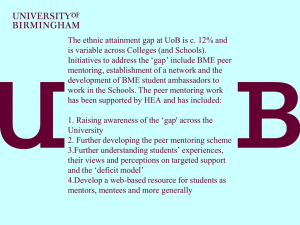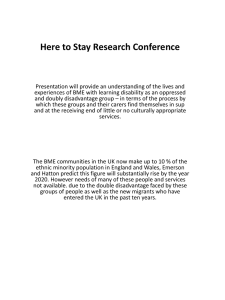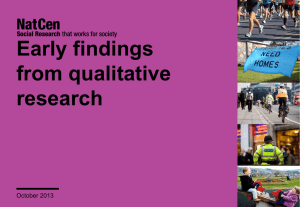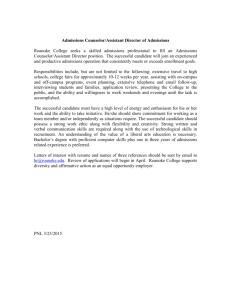School Admissions Policy - Leicestershire County Council
advertisement
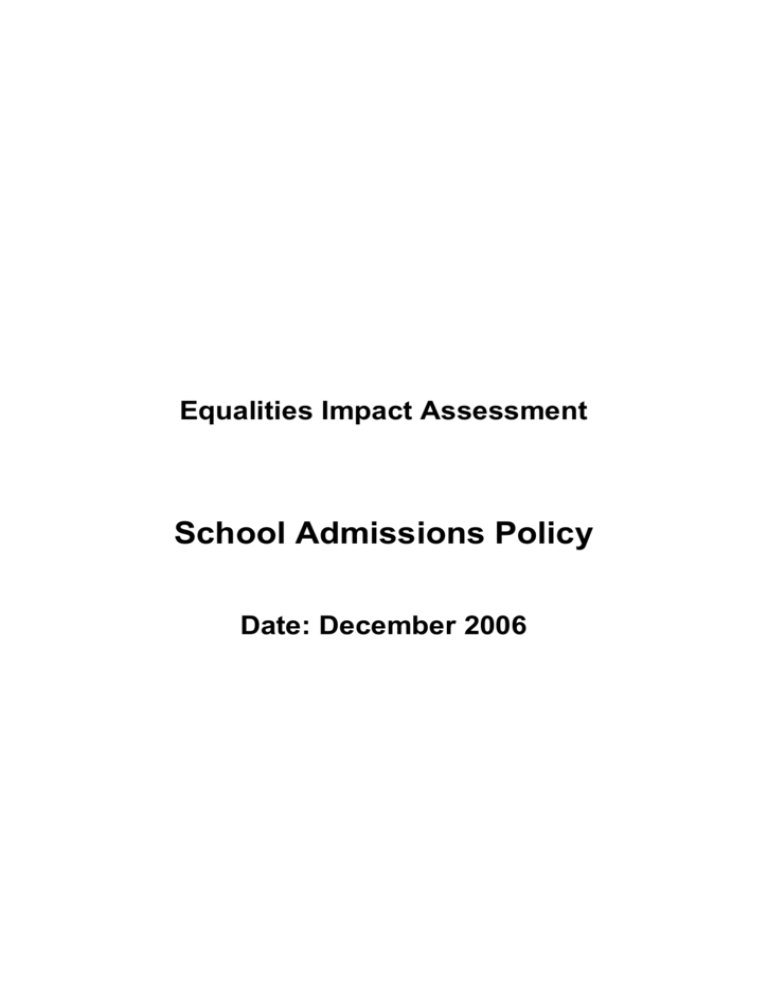
Equalities Impact Assessment School Admissions Policy Date: December 2006 Record of Equality Impact Assessment 1. Department/Service Area Children and Young People’s Service, Access and Welfare Service School Admissions Policy 2. Equality Areas Assessed Race, disability, religion/faith 3. Timescale of the assessment September 2006 - December 2006 4. Who is involved in the EIA? (There should be a minimum of at least 3 officers) Officer involvement Service Manager Deputy Service Manager Stakeholder Involvement Leicestershire parents, in the current transfer cycle, were issued with a Questionnaire (since coordinated admissions, communication with City parents is only made by the City Council). 5. Policy, procedure, service assessed The School Admissions Policy applies to all school age children in Leicestershire who are requesting access to a mainstream education placement. It sets out the process and procedure which is adopted and also the priority criteria for allocating places to an oversubscribed school. 2 6. Data Collection and consultation A parental questionnaire was sent out at the beginning of September 2006 which asked questions which enabled us to ascertain whether parents feel that the policy is fair and objective. The following data was also used as part of this assessment: Black and Minority Ethnic (BME) population in Leicestershire Breakdown of religious groups in Leicester Refusals of requests for a school place by ethnic origin National and local statistics on admissions appeals Percentage of successful first preference requests for a school place Demographic data collected as part of parental questionnaire: BME group Religion or belief Disability Whether the Local Authority complies with the national Code of Practice on Admissions was also considered. 7. Findings Parental Questionnaire 14,219 questionnaires were sent out to Leicestershire parents and a total of 5821 were returned; a 41% return rate. Of the respondents, 232 (1.6%) considered that either they or their child has a disability. The ethnic origin of respondents was as follows: 3 White British Asian Indian Mixed White Caribbean White Irish Asian Bangladeshi Asian Other Black Caribbean Mixed White African Mixed Other Black African Chinese Asian Pakistani White Other Mixed White Asian Other Not Disclosed 85.2% 5.9% 0.8% 0.3% 0.5% 0.5% 0.1% 0.2% 0.7% 0.2% 0.6% 0.3% 1.0% 0.7% 0.1% 3.0% The total White British population of the County is 91.2%. This means that there was a higher percentage response from BME groups than the total population of the County as a whole. The response in terms of ease of application was as follows: Ease of Application no comment 4% not easy 1% easy 32% very easy 63% The vast majority of respondents found the process of application either easy or very easy, with only a small percentage, 80 people ( 1%, rounded to the nearest whole number), finding it difficult. Of these 12 (15%) considered themselves to have a disability and 13 (16.25%) were from a BME group. Application can be made in several ways including written request, on line or by telephone. This is in an effort to make application as easy as possible for parents. Some of those who found the process difficult did so because the new on line process had minor initial problems which have now been eradicated. 4 The response in terms of whether the process is fair was as follows: Is the Admissions Process Fair? no response 4% don't know 13% no 3% yes 80% Further analysis of this question produces the following information in relation to the definition of siblings: 5 Ethnic Origin of Respondents Who disagreed with the Definition of Siblings 60 50 40 30 20 10 te ed os isc l td Af ric an er O th no ity ic et hn As M ix ed W hi r th e As ia n la d ia n Ba ng te O es hi sh Iri n W hi be a te C ar ib In M ix ed W hi As ia n W hi te Br iti sh di an 0 This question is important given the different definition of the term sibling within different cultural groups. However of the 80 people who responded that the definition of siblings used within the policy is unfair, the vast majority were from the “White British” group. Just one respondent out of the 5821, made the point that within some cultural groups, cousins are considered to be siblings. A further question was asked regarding the general rule that only one address is recognised per family, and only one family per address were we are considering catchment entitlement in a full year group. 6 The Ethnic Origin of Respondents Who Disagree With the One Address per Family / One Family Per Address Rule M ixe d W h it e Br itis As h ian W I nd hit ian e Ca rib be an W As h it ian e Iri Ba sh ng lad es As hi ian Ot he M r ixe d Ot W he hit r e Af ric M an ixe d Ot Bl he ac r kA fri ca n Ch As i ne ian se Pa k is ta W ni h M i t ixe e O d th et W er hn hit ic i e ty A sia no td n is c los ed 300 250 200 150 100 50 0 This question is also important in terms of extended family members residing together and this being more evident within some BME cultural groups. Again it can be seen that the vast majority of the 317 respondents who felt the rule was unfair were again from the “White British” group. This would indicate that most BME respondents did not believe that they were being discriminated against . It is important to note that there will be circumstances where two families residing in one property will be allowed a place in an oversubscribed catchment school providing they can show this is their permanent address. So families who do genuinely live together as an extended family group will not be discriminated against because of this. The biggest negative response was to the question of the allocation of places on denominational grounds. The following responses were received: 7 The Religion Of Respondents who Disagree with Priority on Grounds of Faith d isc lo se on e N ot D N er O th lim M us Si kh u in d H C hr is tia n 450 400 350 300 250 200 150 100 50 0 816 respondents felt this kind of prioritisation was unfair; a total of 14.8% or almost 1:6. Interestingly the largest objection was from the Christian respondents; the group who are given priority for faith schools in Leicestershire. More understandably, the second largest response was from those who stated they had no religion. Given the fact that most of these schools are their own admissions authority and that the schools are based on a religious foundation, it is not possible to prioritise without priority being given to adherents of a particular denomination. Refusal of Places For admissions into the academic year 06/07 there were a total of 377 Leicestershire residents refused a place at their preferred school. Of these 71% were “White British”. This means that the number of refusals for children falling into BME groupings was higher than the corresponding percentage of the Leicestershire population as a whole; 29% of applicants refused were from BME groupings, whereas these groups make up only 9% of the population as a whole. A significant amount of research would need to be undertaken to find out the underlying reasons for this. One reason may well be that the area of the County with the most popular and regularly oversubscribed schools, i.e. Oadby and Wigston, is also the area of the County with the highest BME population (19.3%). This does not , however, account entirely for this discrepancy. This is only a snapshot of one year and may not, therefore, be indicative of an ongoing problem. Other relevant considerations may be whether the BME population in a particular age group is higher than others and whether the importance placed on gaining a place in an “excellent” school by some ethnic groups has a bearing, i.e. a higher percentage 8 of applicants for the “best” and therefore most oversubscribed schools in the County may be from BME groups. Appeals The most recent year for which comparative data on the numbers of appeals heard and the number of appeals which were successful is the 2004/2005 academic year. The average of our statistical neighbours of the number of appeals heard as a percentage of the total number of children in the year group is 3.74%. In Leicestershire the percentage was 0.3%. This would indicate that there is a lower number of dissatisfied parents in Leicestershire. The average of our statistical neighbours of the number of successful appeals as a percentage of those heard is 44%. In Leicestershire the percentage was 27.35%. This would indicate that in Leicestershire the panels felt that the decision of the Local Authority was correct in a higher percentage of cases. The School Admissions Code of Practice The Code of Practice is followed closely by Leicestershire in terms of what criteria are used for prioritising applicants for places. The Code of Practice sets out criteria that are not appropriate in terms of equal opportunities and avoiding discrimination. Leicestershire’s policy is fully consistent with this guidance. Over many years there has been no successful challenge to Leicestershire’s admissions policy. Accessibility Issues Account of particular need, i.e. disability which makes a particular school suitable, or unsuitable, is taken account of within the policy. For example, a young person with a disability would receive priority for an accessible school if their catchment school was inaccessible under the Social, Medical and Domestic category. 8. Conclusions 9 Responses to the questionnaire indicate that Leicestershire parents are happy that the process for allocating school places is fair and is not discriminatory. Statistics on appeals also support this view. The policy and procedure does not appear to have an adverse impact on BME or disabled groups although there is a small amount of evidence from one year that a disproportionate number of BME applicants were refused places. 9. Actions Further monitoring of refusals by ethnic groups should take place in 07/08 to discover whether this is an ongoing issue or whether 06/07 was unusual. 10. Monitoring Monitoring of the number of refusals by ethnic group should be undertaken in November 2007 for admissions in September 07. If necessary further investigation should be undertaken to feed into the annual review of the admissions policy. 11. Authorisation a) Name and position of officer Head of Pupil Support authorising the EIA (this should be the head of service) 12. Contact a) Contact details of officer to discuss EIA with if different from section 11. above Service Manager, Access and Welfare 10



